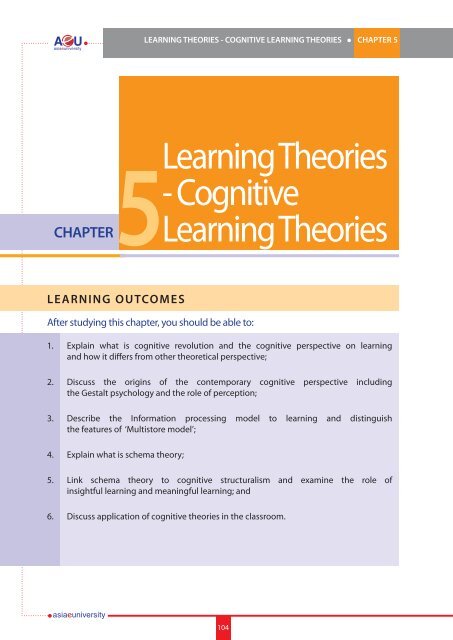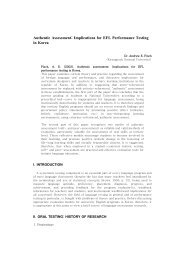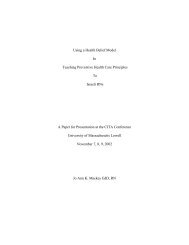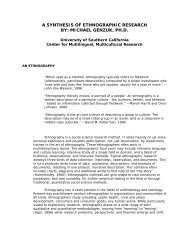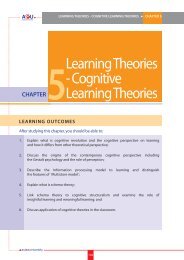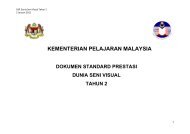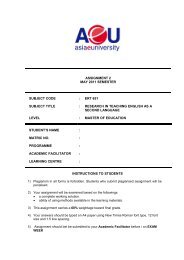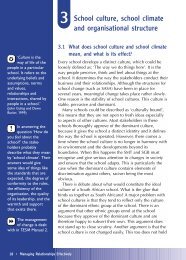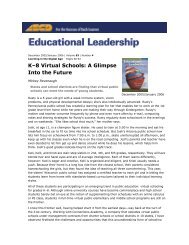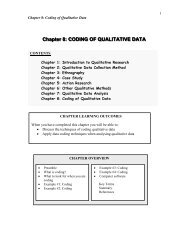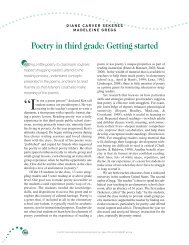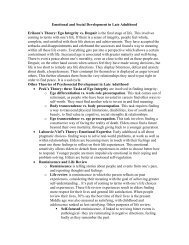Learning Theories - Cognitive Learning Theories CHAPTER
Learning Theories - Cognitive Learning Theories CHAPTER
Learning Theories - Cognitive Learning Theories CHAPTER
You also want an ePaper? Increase the reach of your titles
YUMPU automatically turns print PDFs into web optimized ePapers that Google loves.
<strong>CHAPTER</strong><br />
LEARNING THEORIES - COGNITIVE LEARNING THEORIES l <strong>CHAPTER</strong> 5<br />
<strong>Learning</strong> <strong>Theories</strong><br />
- <strong>Cognitive</strong><br />
<strong>Learning</strong> <strong>Theories</strong><br />
5<br />
LEARNING OUTCOMES<br />
After studying this chapter, you should be able to:<br />
1. Explain what is cognitive revolution and the cognitive perspective on learning<br />
and how it differs from other theoretical perspective;<br />
2. Discuss the origins of the contemporary cognitive perspective including<br />
the Gestalt psychology and the role of perception;<br />
3. Describe the Information processing model to learning and distinguish<br />
the features of ‘Multistore model’;<br />
4. Explain what is schema theory;<br />
5. Link schema theory to cognitive structuralism and examine the role of<br />
insightful learning and meaningful learning; and<br />
6. Discuss application of cognitive theories in the classroom.<br />
104
<strong>CHAPTER</strong> 5 l LEARNING THEORIES - COGNITIVE LEARNING THEORIES<br />
INTRODUCTION<br />
Sometimes you wonder why the<br />
teacher use colourful chalk with some<br />
of the words written on the board.<br />
Sometimes the teacher write in capital<br />
letter with important words.<br />
These are useful as guides for the students to differentiate the important and unimportant<br />
facts. In other words, accurate perception is important in good learning. It is part of the<br />
Gestalt principles. Clearly, these principles are useful as guide for teachers as they<br />
organize their materials and learning activities. So in this chapter, we will discuss the origin<br />
and features of cognitive theory and relate them to cognitive constructivism and meaningful<br />
learning. Figure 5.1 give you some ideas related to cognitive learning theory covered in<br />
this topic.<br />
Figure 5.1: <strong>Cognitive</strong> learning theory covered in this topic.<br />
105<br />
i.<br />
105
5.1 COGNITIVE REVOLUTION<br />
LEARNING THEORIES - COGNITIVE LEARNING THEORIES l <strong>CHAPTER</strong> 5<br />
The “<strong>Cognitive</strong> revolution” is the name for an intellectual movement in the 1950s that<br />
began with what are known collectively as the cognitive sciences. It began in the modern<br />
context of greater interdisciplinary communication and research.<br />
The relevant areas of interchange were the combination of psychology, anthropology and<br />
linguistics with approaches developed within the then-nascent fields of artificial intelligence,<br />
computer science and neuroscience. Two of the prominent figures in cognitive psychology<br />
are Jean Piaget (1896 – 1980) and Lev Vygotsky (1896 – 1934).<br />
Figure 5.2 shows the relevant areas of interchange that know as cognitive revolution.<br />
Figure 5.2: The combinations of cognitive revolution<br />
The cognitive revolution in psychology was a response to behaviourism, which was the<br />
predominant school in experimental psychology at the time. This school was heavily influenced<br />
by Ivan Pavlov, B.F. Skinner, and other physiologists. They proposed that psychology<br />
could only become an objective science if it is based on observable behaviour in test<br />
subjects. Since mental events are not publicly observable, behaviourist psychologists<br />
avoided description of mental processes or the mind in their literature.<br />
Psychoanalytic theories on the other hand stress the importance of the unconscious while<br />
cognitive theories emphasize on conscious thoughts. 3 important cognitive theories are<br />
Piaget’s cognitive developmental theory, Vygotsky’s sociocultural cognitive theory and<br />
information processing theories, which we have discussed in previous chapter.<br />
<strong>Cognitive</strong> Psychology focuses on the study of how people think, understand, and know.<br />
They emphasizes on learning how people comprehend and represent the outside world<br />
within themselves and how our ways of thinking about the world influence our behaviour.<br />
106
<strong>CHAPTER</strong> 5 l LEARNING THEORIES - COGNITIVE LEARNING THEORIES<br />
From a cognitive learning perspective, learning involves the transformation of information<br />
in the environment into knowledge that is stored in the mind. <strong>Learning</strong> occurs when new<br />
knowledge is acquired or existing knowledge is modified by experience. Among the main<br />
issues studied and discussed by cognitive psychologists are:<br />
• The cognitive theories present a positive view of development, emphasizing conscious<br />
thinking.<br />
• The cognitive theories (especially Piaget’s and Vygotsky’s) emphasize on the individual’s<br />
active construction of understanding.<br />
• Piaget’s and Vygotsky’s theories underscore the importance of examining developmental<br />
changes in children’s thinking.<br />
• The information processing theory offers detail descriptions of cognitive processes.<br />
What are the differences between Behavioural and <strong>Cognitive</strong> perspective<br />
pertaining to human learning.<br />
http://dakota.fmpdata.net/PsychAI/PrintFiles/<strong>Cognitive</strong>.pdf<br />
107<br />
i.<br />
107
5.2 GESTALT PSYCHOLOGY<br />
LEARNING THEORIES - COGNITIVE LEARNING THEORIES l <strong>CHAPTER</strong> 5<br />
Gestalt is a perspective focuses on the belief that human<br />
consciousness cannot be broken down into its elements. This<br />
approach to psychology was founded on the concept of the<br />
gestalt, or whole. Gestalt psychologists led by Max Wertheimer<br />
(1880 - 1943), Wolfgang Kohler (1887 – 1967) and Kurt Koffka<br />
(1886 – 1941) have made substantial contributions to our<br />
understanding of perception. Gestaltists pointed out that<br />
perception has meaning only when it is seen as a whole.<br />
108<br />
Max Wertheimer<br />
Figure 5.3 illustrated the gestalt perception which saw that the whole is different from<br />
the sum of the parts.<br />
Figure 5.3: Gestalt saw that the whole is different from the sum of the parts<br />
Gestalt psychology(also Gestalt of the Berlin School) is a theory of mind and brain that<br />
proposes that the operational principle of the brain is holistic, parallel, and analog, with<br />
self-organizing tendencies, or that the whole is different from the sum of its parts. The<br />
Gestalt effect refers to the form-forming capability of our senses, particularly with respect<br />
to the visual recognition of figures and whole forms<br />
instead of just a collection of simple lines and curves.<br />
Figure 5.4 shows an example of picture that contains the<br />
gestalt theory.<br />
The word Gestalt in German literally means “shape”<br />
or “figure”. Gestaltists performed many researches on<br />
perception and human learning. They believed learning<br />
is the result from good perception, which enable an<br />
individual to form correct concept in their mind. Later<br />
on they proposed the principles or law for perceptual<br />
organization. Henceforth, we will discuss these<br />
principles, which consisted of six principles, which<br />
are good form, figure or ground, similarity, proximity,<br />
closure, and continuity.<br />
Figure 5.4: What did you see in<br />
this picture? A saxophone player<br />
or a lady?
<strong>CHAPTER</strong> 5 l LEARNING THEORIES - COGNITIVE LEARNING THEORIES<br />
i) The Law of Good form or Pragnanz<br />
The word ‘Gestalt’ means ‘form’ or ‘shape’. Gestalt psychologists were of the view<br />
that psychological organization will always be as ‘good’ as prevailing conditions allow. For<br />
Gestalt psychologists, form is the primitive unit of perception. When we perceive, we<br />
will always pick out form. Our perceptions are influenced by our past experiences. This<br />
principle is also called Pragnanz Law. (Tan Oon Seng et al., 2003).<br />
ii) The Law of Figure – Ground Discrimination<br />
The Rubin vase shown in Figure 5.5 is an<br />
example of this tendency to pick out form.<br />
We do not simply see black and white shapes,<br />
we also see two faces and a vase. What about<br />
Figure 5.6? Do you see a young lady or an old<br />
lady?<br />
Figure 5.6: Young Lady or Old Lady?<br />
(From Spooncer, 1992 p.35)<br />
109<br />
Figure 5.5: Two faces or a vase? (From Spooncer, 1992<br />
p.35)<br />
The problem here is that we see the two forms<br />
of equal importance. If the source of this message<br />
wants us to perceive a vase, then the vase is<br />
the intended figure and the black background is<br />
the ground. The problem here is a confusion of<br />
figure and ground.<br />
i.<br />
109
iii) The Law of Proximity<br />
iv) The Law of Similarity<br />
LEARNING THEORIES - COGNITIVE LEARNING THEORIES l <strong>CHAPTER</strong> 5<br />
Figure 5.7: Two men and the table.<br />
When you look at a you see (a man + a man) + a table.<br />
When you look at b you see (a man + a table) + a man.<br />
Things, which are close together in space or time, tend to be perceived as grouped together.<br />
Thus, if you want your audience to associate the product with the presenter, put them close<br />
together; if you want them to perceive two ideas as associated, present them in close<br />
proximity.<br />
Figure 5.8: Trees in different shapes<br />
Things that are similar are likely to form ‘Gestalten’ as groups. So, in the graphic labelled<br />
with A(on the left), you probably see an X of fir trees against a background of the others. In<br />
the graphic labelled with B(on the right), you may see a square of the other trees, partly<br />
surrounded by fir trees. The fact that, in picture labelled with A, we see an X while in the<br />
picture labelled with B, we can see a square, incidentally, an example of good form or<br />
Prägnanz.<br />
110
<strong>CHAPTER</strong> 5 l LEARNING THEORIES - COGNITIVE LEARNING THEORIES<br />
iv) The Law of Closure<br />
Figure 5.9: Words and shape<br />
vi) The Law of Continuity<br />
Perceptually, we have the tendency to fill in<br />
the gaps. In other words, we can still read<br />
WASHO, see the square and read ‘perception’<br />
despite the missing information. You probably<br />
know that redundancy can be deliberately<br />
added into messages to increase the likely<br />
fidelity of reception, but the Gestalt psychologists’<br />
law of closure suggests that it certainly<br />
is not always necessary.<br />
When you see figure 5.10(1), you are much more likely to see it as consisting of two lines<br />
like 5.10(1a), rather than of the two shapes 5.10(1b).This is the Gestalt principle of<br />
continuity which saw a single unbroken line is likely to be seen as an entity.<br />
Figure 5.10: Lines and figures<br />
When you see figure 5.11(2), you are much more likely to see it as consisting of two lines<br />
like 5.11(2a and 2b), rather than as the series of shapes 5.11(2c).<br />
111<br />
i.<br />
111
LEARNING THEORIES - COGNITIVE LEARNING THEORIES l <strong>CHAPTER</strong> 5<br />
Figure 5.11: Lines and Figures<br />
Perceptually, where figures are defined by a single unbroken line, they tend to be seen as an<br />
entity. This principle is of course of particular importance in teaching. Even something as<br />
simple as drawing a squiggle to link up apparently disparate elements on a page can be<br />
helpful in suggesting to the reader that they are parts of a whole.<br />
According to Gestalt psychology perceptual organization influence good<br />
learning. Explain the six perceptual law regarding human perception by<br />
Gestaltists.<br />
112
<strong>CHAPTER</strong> 5 l LEARNING THEORIES - COGNITIVE LEARNING THEORIES<br />
5.3 INfORMATION PROCESSING MOdEL (IPM)<br />
The Information Processing Theory approach to the study of cognitive development<br />
evolved out of the American experimental tradition in psychology. Information processing<br />
theorists proposed that like a computer, a human mind is a system that processes information<br />
through the application of logical rules and strategies. The mind has a limited capacity for<br />
the amount and nature of the information it can process.<br />
Figure 5.12: Information processing model<br />
The terminology of the Information Processing Model as illustrated in Figure 5.12<br />
emphasizing the significance of “encoding” (input) of information, the “storage” of<br />
information, and the “retrieval” (access) of information. The language and the metaphor<br />
often used is one of the minds of as computer. IPM theorist, U.Neisser, maintains that the<br />
correlation between cognition and computers is a powerful one(Benjafeld, 1992 in Tan, 2003).<br />
Most IPM theorists see the computer as only a metaphor for human mental activity.<br />
Finally, just as the computer can be made into a better information processor by<br />
changing its hardware and its software (programming), so do children who become more<br />
sophisticated thinkers through changes in their brains and sensory systems (hardware) and<br />
in the rules and strategies (software) that they learn.<br />
Describe the features of three stages of memory storage in Information<br />
Processing model.<br />
113<br />
i.<br />
113
LEARNING THEORIES - COGNITIVE LEARNING THEORIES l <strong>CHAPTER</strong> 5<br />
5.4 MULTI-STORE MOdEL Of MEMORy<br />
One of the major issues in cognitive psychology is the study of memory. The dominant view<br />
is labelled the “stage theory” and is based on the work of Atkinson and Shiffrin (1968).<br />
The Atkinson-Shiffrin model(also known as the Multi-store model, Multi-memory model<br />
and the Modal model) is a psychological model proposed in 1968 by Richard Atkinson<br />
and Richard Shiffrin as a proposal for the structure of memory. It proposed that human<br />
memory involves a sequence of three stages, which are sensory memory, short-term<br />
memory and long-term memory as shown in Figure 5.13.<br />
Figure 5.13. : Multi-store model of memory(also known as the, Multi-memory model and the Modal model)<br />
The multi-store model is a very common model of memory assuming that there are different<br />
types of memory used for different tasks. It is an explanation of how memory processes work.<br />
You hear, see and feel many things, but you can only remember a few. These link together<br />
in an effective sequence as explained below.<br />
a) Sensory Memory<br />
The first stage is sensory memory, which contains receptors that briefly hold on to only<br />
that information that enters through our senses. Sensory memory is affiliated with the<br />
transudation of energy(change from one form of energy to another). The environment makes<br />
a variety of sources of information(light, sound, smell, heat, cold, etc.) available, but<br />
the brain only understands electrical energy. The body has special sensory receptor cells<br />
that transducer(change from one form of energy to another) this external energy to something<br />
the brain can understand. In the process of transudation, a memory is created. This memory<br />
is very short (less than 1/2 second for vision; about 3 seconds for hearing).<br />
114
<strong>CHAPTER</strong> 5 l LEARNING THEORIES - COGNITIVE LEARNING THEORIES<br />
Figure 5.14: Sense organ<br />
The sense organs have a limited ability to store information about the world in a fairly<br />
unprocessed way for less than a second.<br />
Example:<br />
• The visual system possesses iconic memory for visual stimuli such as<br />
shape, size, colour and location (but not meaning)<br />
• The hearing system has echoic memory for auditory stimuli.<br />
Coltheart et al (1974) have argued that the momentary freezing of visual input allows us to<br />
select which aspect of the input should go on for further memory processing. The existence<br />
of sensory memory has been experimentally demonstrated by Sperling(1960) using a<br />
tachistoscope.<br />
b) Short-term memory<br />
The second stage is short-term memory, a temporary storage facility. Short-term memory<br />
is also called working memory and relates to what we are thinking about at any given<br />
moment in time.<br />
According to Freudian:<br />
“Short term memory is conscious memory. It is created by our paying attention to<br />
an external stimulus, an internal thought, or both. It will initially last somewhere<br />
around 15 to 20 seconds unless it is repeated (called maintenance rehearsal) at<br />
which point it may be available for up to 20 minutes”.<br />
Freudian<br />
115<br />
i.<br />
115
LEARNING THEORIES - COGNITIVE LEARNING THEORIES l <strong>CHAPTER</strong> 5<br />
Figure 5.15: The frontal lobe, the structure associated with working memory.<br />
The hypothalamus is a brain structure thought to be involved in this shallow processing<br />
of information. While the frontal lobe of the cerebral cortex as lebelled in Figure 5.15 is the<br />
structure associated with working memory.<br />
For Example<br />
You are processing the words you read on the screen in your frontal lobes.<br />
However, if I ask, “What is your telephone number?” Your brain immediately<br />
calls that from long-term memory and replaces what was previously there.<br />
Another process that is sometimes used to expand the capacity of short-term memory is called<br />
chunking. Chunking is a process by which we group individual bits of information into some<br />
types of large, more meaningful unit.<br />
c) Long-term memory<br />
The third stage is long-term memory(LTM). LTM provides the lasting retention of<br />
information, from minutes to a lifetime. Long-term memory appears to have an almost<br />
limitless capacity to retain information, but it could never be measured, as it would take<br />
too long.<br />
Contemporary psychologists agree that long-term memory can be divided into subtypes<br />
of declarative and procedural memory(Santrock, 2008). Declarative memory is subdivided<br />
into episodic memory and semantic memory.<br />
116
<strong>CHAPTER</strong> 5 l LEARNING THEORIES - COGNITIVE LEARNING THEORIES<br />
Procedural memory<br />
• Procedural memory is nondeclarative knowledge in the form of skills and<br />
cognitive operations.<br />
• Procedural memory cannot be consciously recollected, at least not in the form<br />
of specific events or facts.<br />
• Procedural memory is sometimes called “knowing how,” and recently it also has<br />
been described as “implicit memory.”<br />
• When students apply their abilities to perform a dance, their procedural memory<br />
is at work.<br />
declarative memory<br />
• Declarative memory is the conscious recollection of information, such as specific<br />
facts or events that can be verbally communicated.<br />
• Declarative memory has been called “knowing that” and more recently has been<br />
labelled “explicit memory.”<br />
• Demonstrations of student’s declarative memory such as describing a basic principle<br />
of math.<br />
Episodic<br />
• Episodic memories are the memories we have for times and places (like first day<br />
Aidilfitri celebration).<br />
• Information encoded in our episodic memory is in the form of images.<br />
Semantic memories<br />
• Semantic memories are our memories for general facts and concepts. Most of what<br />
we learned in school (instructional content) is stored in our semantic memories.<br />
117<br />
i.<br />
117
LEARNING THEORIES - COGNITIVE LEARNING THEORIES l <strong>CHAPTER</strong> 5<br />
Long-term memory is also called preconscious and unconscious memory in Freudian terms.<br />
• Preconscious means that the information is relatively easily recalled (although it may<br />
take several minutes or even hours) while<br />
• Unconscious refers to data that is not available during normal consciousness.<br />
It is the preconscious memory that is the focus of cognitive psychology as it relates to the<br />
long-term memory. The levels of processing theory, however, has provided some<br />
researches that attest to the fact that we “know” more than we can easily recall.<br />
According to Brynes,<br />
There are two process in appear in facilitating our efforts, they are rehearsal<br />
(practice) and elaboration.<br />
(Byrnes, 1996).<br />
Elaboration of information processing strategy emphasizes links between the information<br />
stored in the long-term memory and the new information. When we talk about information<br />
processing model, we cannot avoid discussing memory and forgetting, how to enhance<br />
student’s long-term memory and what factors contribute to forgetting. We will discuss it<br />
later in the next chapter.<br />
118
<strong>CHAPTER</strong> 5 l LEARNING THEORIES - COGNITIVE LEARNING THEORIES<br />
5.4.1 Steps To Enhance Long-Term Memory<br />
According to Santrock,<br />
“Long term memory meaning information is retained in the long term memory over<br />
time”.<br />
(Santrock, 2007)<br />
In order to retain information it has to go through stages mentioned earlier, encoding,<br />
storage, and retrieval. Teacher can help students store the information in the long-term memory<br />
using methods such as positive transfer, dual coding theory, rehearsal, instructional<br />
strategies, mnemonics, and memory gadgets or devices. Descriptions of these methods<br />
are explained in Figure 5.16.<br />
Positive transfer<br />
dual coding theory<br />
Rehearsal<br />
Instructional strategies<br />
• Teacher may transfer learning using appropriate strategies or<br />
activities.<br />
• Schema theory suggest teacher to activate prior knowledge<br />
and make connection with new knowledge to enhance<br />
student’s learning.<br />
• In dual coding theory, theorist suggest that we remember<br />
better when two processes are engage such as visual learning<br />
and verbal learning.<br />
• For example, a teacher guide young children to write the digit<br />
“8” may provide verbal instruction as well as visual presentation.<br />
She may begin with pencil on the chil’s paper saying, “Let’s start<br />
by writing the letter S and then curving back to join the open<br />
end joining something like that looks like two circles touching<br />
each other on the side.”<br />
• Student may use two types of rehearsal that is maintenance<br />
and elaborative.<br />
- Maintenance rehearsal is rote repetition of the information<br />
in STM, like repeating phone number a few dozen times.<br />
- Elaborative rehearsal is not based on mere repetition but<br />
occurs when the information is expanded, embellished on,<br />
and related to other concepts already in LTM.<br />
• Teacher may use instructional strategies that actively involved<br />
students in learning such as group discussion, singing and<br />
reading aloud, cooperative learning, inquiry, discovery,<br />
experimenting or leaning by doing.<br />
119<br />
i.<br />
119
Mnemonics<br />
Memory gadgets or<br />
devices<br />
LEARNING THEORIES - COGNITIVE LEARNING THEORIES l <strong>CHAPTER</strong> 5<br />
5.4.2 The Information Processing Theory of Forgetting<br />
According to Sprinthall & Sprinthall<br />
• Teacher may use mnemonic devices such as acronyms whilst<br />
teaching important facts.<br />
- Example of acronym is SMS for short messages service or<br />
FELDA for Federal Land Development Aothority.<br />
• Another type of mnemonic such as peg word..<br />
- Example of pegword is “Emak Suka Pizza” for types of memory<br />
in long term memory that is Episodic, Semantic, and<br />
Procedural.<br />
• Students may use memory device such as mind mapping,<br />
graphic organizer, fish – bone diagram, tree diagram, etc<br />
to enhance their understanding and good memory.<br />
Figre 5.16: List of methods to help students store the information, in the long-term memory<br />
“Forgetting is defined as the inability to retrieve information”<br />
120<br />
(Sprinthall & Sprinthall, 1994)<br />
Figure 5.17 is an Information Processing Model. This model shows the two major reasons<br />
of in ability to retrieve information in long-term memory. The 2 major reasons are decay<br />
and interference.<br />
Figure 5.17: Decay and interference in the Information Processing Model
<strong>CHAPTER</strong> 5 l LEARNING THEORIES - COGNITIVE LEARNING THEORIES<br />
Decay<br />
• Decay is the passive loss of the memory trace due to inactivity or lack of rehearsal.<br />
Actually this is not a new idea.<br />
• Thorndike has postulated three major laws of learning and one of it is law of exercise.<br />
In this law, Thorndike stated that the more an S – R connection is used, the stronger<br />
it becomes; conversely, the less it is use the weaker it becomes.<br />
• Hence, through inactivity, the S – R connection simply weaken over time.<br />
Interference:<br />
• Interference takes place when the recall of one event is inhibited by the incursion of<br />
another event.<br />
• There are two types of interference that is proactive and retroactive interference.<br />
• Proactive inhabitation occurs when you fail to learn subject B because of subject A,<br />
which you learned earlier, because it disrupted your recall of the facts in subject B.<br />
• Retroactive interference occurs when the learning of new material (B) prevents the<br />
recall of the older material (A).<br />
Explain briefly the three stages multi-store model of memory by<br />
Atkinson and Schriffin.Discuss how teacher can help student<br />
memorize important facts.<br />
5.5 THE SCHEMA THEORy<br />
R. C. Anderson, a respected educational psychologist, developed schema theory. This<br />
learning theory views organized knowledge as an elaborate network of abstract mental<br />
structures which represent one’s understanding of the world. The term schema was first<br />
used by Piaget in 1926, so it was not an entirely new concept. Anderson, however,<br />
expanded the meaning.<br />
Contemporary learning theory embraces schema theory in an attempt to explain how<br />
information is best encoded in the long-term memory. The theory emphasizes the nature<br />
and purpose of schemata as the fundamental elements of cognitive processing (Douchy &<br />
Bouwens, 1990 in Tan et. al. 2003). They are prior knowledge linkages, and they influence<br />
the amount and proficiency of our learning. Research by schema theorists indicates that<br />
abstract concepts are best understood after a foundation of concrete and relevant<br />
information has been established (Schallert 1982:26). The general knowledge provides a<br />
framework into which the newly-formed structure can be fitted.<br />
121<br />
i.<br />
121
LEARNING THEORIES - COGNITIVE LEARNING THEORIES l <strong>CHAPTER</strong> 5<br />
Figure 5.18 lists some characteristics of schemata according to Anderson (1977:418--419):<br />
• Schemata are always organized meaningfully, can be added to, and, as an individual<br />
gains experience, develop to include more variables and more specificity.<br />
• Each schema is embedded in other schemata and itself contains subschema.<br />
• Schemata change moment by moment as information is received.<br />
• They may also be reorganized when incoming data reveals a need to restructure<br />
the concept.<br />
• The mental representations used during perception and comprehension, and<br />
which evolve as a result of these processes, combines to form a whole, which is<br />
greater than the sum of its parts.<br />
Diagram of a sample schema<br />
Figure 5.18: Characteristics of schemata<br />
Figure 5.19 shows a diagram that describes how a person’s schema of “egg” might include.<br />
Figure 5.19: A diagram that describes “egg” using the schema theory<br />
122
<strong>CHAPTER</strong> 5 l LEARNING THEORIES - COGNITIVE LEARNING THEORIES<br />
Schemata are an effective tool for understanding the world. Through the use of schemata,<br />
most everyday situations do not require effortful thought which absolutely automatic<br />
thought is all that is required. People can quickly organize new perceptions into schemata<br />
and act effectively without effort.<br />
Example:<br />
• Most people have a stairway schema and can apply it to climb staircases they’ve<br />
never seen before.<br />
This theory would suggests that our prior knowledge can facilitate or enhance transfer<br />
of a learning task. It is also true that prior knowledge can inhibit or interfere with our<br />
acquisition of new information (Leinhardt, 1992 in Tan et. al. 2003).<br />
Example:<br />
• Many people have expressed difficulty learning to use a new software package<br />
because their prior familiarity with the preceding versions seem to interfere.<br />
What is the schema theory? Explain why prior knowledge is important<br />
in the acquisition of new knowledge.<br />
5.6 COGNITIVE STRUCTURALISME<br />
<strong>Cognitive</strong> structuralism was founded by Jean Piaget(1896-1980) and other cognitive<br />
psychologists. Whereas social constructivism was founded by Vygotsky(1896-1934). There<br />
are several opinions related to cognitive structuralism according to psychologists.<br />
According to Leinhardt,<br />
“The awareness of interrelationships between stimuli or the use of appropriate schemata<br />
are significant to cognitive learning and to teaching and classroom learning”<br />
123<br />
Leinhardt, 1992.<br />
i.<br />
123
According to Leinhardt, Byrness<br />
LEARNING THEORIES - COGNITIVE LEARNING THEORIES l <strong>CHAPTER</strong> 5<br />
“Schemata serve several functions in learning: categorizing, remembering, comprehending<br />
and problem solving.”<br />
“First, schemata or prior knowledge links categorize our experiences more efficiently<br />
for processing. This categorization of information facilitates the processes of<br />
remembrance (recall), and comprehension (understanding), all of which make<br />
problem solving more productive”<br />
Alba and Hasher (cf. Benjafield,) suggest that,<br />
124<br />
( Byrness, 1996)<br />
“Schema facilitates the selection of information based on our interests. Further, once<br />
selected, the schema enable the selected material to be organized abstractly and<br />
assist the individual in the processes of interpreting and integrating the new<br />
material, based on what he or she knows already”<br />
Alba and Hasher (cf. Benjafield, 1992)<br />
Clearly, the cognitive constructivists (or “connectionists”) suggest that,<br />
“For teachers to promote more effective learning the teacher needs to link new<br />
information to familiar information selectively in as learner – satisfying a format as<br />
possible”<br />
(Hinson, 1988; Sanchez & Lopes, 1993; Ellis et al., 1994 in Tan et al., 2003).<br />
Although cognitivists like Jerome Bruner and David Ausubel described ways of utilizing<br />
schema theory in classroom learning, but their perspectives on the structuring of prior<br />
knowledge linkages differed. We will discuss it in the next section.
<strong>CHAPTER</strong> 5 l LEARNING THEORIES - COGNITIVE LEARNING THEORIES<br />
5.7 MEANINGfUL LEARNING<br />
David Ausubel (1968) is a psychologist who advanced a theory, which contrasted<br />
meaningful learning from rote learning.<br />
In Ausubel’s view,<br />
“To learn meaningfully, students must relate new knowledge (concepts and propositions)<br />
to what they already know.”<br />
Ausubel<br />
5.7.1 Advanced Organizer<br />
Ausubel (1968) proposed the notion of an advanced organizer as a way to help students<br />
link their ideas with new materials or concepts. Ausubel’s theory of learning claims that<br />
new concepts to be learned can be incorporated into more inclusive concepts or ideas.<br />
These more inclusive concepts or ideas are advance organizers. Advance organizers<br />
can be verbal phrases(the paragraph you are about to read is about Albert Einstein) or a<br />
graphic. In any case, the advance organizer is designed to provide, what cognitive<br />
psychologists call, the “mental scaffolding: to learn new information”.<br />
Figure 5.20 shows an example of leaning methods (KWL method) that applied the idea<br />
of advanced organizer in meaningful learning.<br />
Figure 5:20: Using “KWL” as an Advanced Organizer<br />
125<br />
i.<br />
125
LEARNING THEORIES - COGNITIVE LEARNING THEORIES l <strong>CHAPTER</strong> 5<br />
5.7.2 Rote and Meaningful <strong>Learning</strong><br />
Rote learning<br />
Meaningful learning refers to the concept that the learned knowledge is fully understood<br />
by an individual and that the individual knows how that specific fact relates to other<br />
stored facts (stored in your brain that is). To understand this concept, it is good to<br />
contrast meaningful learning with the much less desirable, rote learning.<br />
Rote learning is where you memorize something<br />
without full understanding and you do not know how<br />
the new information relates to your other stored<br />
knowledge. For our example, let us say we learn 5<br />
facts in a math course during a full semester by rote<br />
learning. This can be illustrated in Figure 5.21.<br />
The 5 facts (labelled 1-5) are stored in memory as<br />
separate items although in real life they are related to<br />
each other. When a student rote learned these facts,<br />
the brain stored them as distinct, unrelated knowledge<br />
that can only be recalled individually (one<br />
fact at a time). When this student recalls 1 fact the<br />
Figure 5.21: Rote learning<br />
other 4 facts are not recalled (or activated) at that moment.<br />
In other words, thinking about fact 5 does not lead the<br />
student to think about facts 1-4. Contrast that to the below discussion on recall after<br />
meaningful learning.<br />
Meaningful learning<br />
Figure 5.22: Meaningful learning<br />
When meaningful learning occurs(using our example of<br />
5 math facts) the facts are stored in a relational manner<br />
(see Figure 5.220). That is, the brain stores them<br />
together because they are related to each other. Now,<br />
when 1 fact is recalled, the other facts are also recalled<br />
at that moment(or shortly thereafter). In other words,<br />
recalling fact 5 activates the memory for facts 2 and 4,<br />
and this in turn leads to recalling facts 1 and 3. This<br />
phenomenon is called the spread of activation. This is<br />
the gist of meaningful learning. Problem-solving for this<br />
student would be easier than for the student who rote<br />
learned the same 5 facts.<br />
126
<strong>CHAPTER</strong> 5 l LEARNING THEORIES - COGNITIVE LEARNING THEORIES<br />
5.7.3 What is Meaningful <strong>Learning</strong> Experience?<br />
In order to effectively integrate technology into a meaningful learning experience, we<br />
must first have a clear understanding of what a meaningful learning experience is. Some<br />
ideas about a meaningful learning experience are listed below.<br />
What is meaningful learning experience is?<br />
• Occurs when learners actively interpret their experience using internal, cognitive<br />
operations.<br />
• Requires that teachers change their role from sage to guide.<br />
• Since students learn from thinking about what they are doing, the teacher’s role<br />
becomes one of stimulating and supporting activities that engage learners in thinking.<br />
- Teachers must also be comfortable that this thinking may transcend their own<br />
insights.<br />
• Requires knowledge to be constructed by the learner, not transmitted from the<br />
teacher to the student (Jonassen, et al., 1999).<br />
Figure 5.18: Characteristics of schemata<br />
5.7.4 Attribute of Meaningful <strong>Learning</strong><br />
Meaningful learning requires knowledge to be constructed by the learner, not transmitted<br />
from the teacher to the student. According to Jonassen, et al. (1999), meaningful learning<br />
contains 8 primary attribute. The attributes are active or manipulative, constructive,<br />
reflective, intentional, complex, contextual, collaborative, and conversational as shown in<br />
figure 5.22.<br />
Figure 5.23: Attribute of meaningful learning<br />
127<br />
i.<br />
127
Jonassen descibes those attribute as follows:<br />
MEANINGFUL LEARNING ACCORDING TO JONASSEN<br />
LEARNING THEORIES - COGNITIVE LEARNING THEORIES l <strong>CHAPTER</strong> 5<br />
Active (manipulative):<br />
• We interact with the environment manipulate the objects within it and<br />
observe the effects of our manipulations.<br />
Constructive and reflective:<br />
• Activity is essential but insufficient for meaningful learning. We must<br />
reflect on the activity and our observations, and interpret them in<br />
order to have a meaningful learning experience.<br />
Intentional:<br />
• Human behaviour is naturally goal-directed. When students actively<br />
try to achieve a learning goal that they have articulated, they think<br />
and learn more. For students to experience meaningful learning, they<br />
must be able to articulate their own learning goals and monitor their<br />
own progress. interpret them in order to have a meaningful learning<br />
experience.<br />
Authentic (complex and contextual):<br />
• Thoughts and ideas rely on the contexts in which they occur in order to<br />
have meaning. Presenting facts that are stripped from their contextual<br />
clues divorces knowledge from reality. <strong>Learning</strong> is meaningful, better<br />
understood and more likely to transfer to new situations when it<br />
occurs by engaging with real-life, complex problems.<br />
Cooperative (collaborative and conversational):<br />
• We live, work and learn in communities, naturally seeking ideas and assistance<br />
from each other, and negotiating about problems and how to solve<br />
them. It is in this context that we learn there are numerous ways to view<br />
the world and a variety of solutions to most problems. Meaningful learning,<br />
therefore, requires conversations and group experiences.<br />
5.7.5 Experiencing the Meaningful <strong>Learning</strong><br />
To experience meaningful learning, students need<br />
to do much more than access or seek information.<br />
They need to know how to examine, perceive,<br />
interpret and experience information. There are<br />
several proposed structuring strategies for teachers<br />
to enhance their teaching method such as advanced<br />
organizers and expository teaching by David<br />
Ausubel and mediators as explained in figure 5.24.<br />
128
<strong>CHAPTER</strong> 5 l LEARNING THEORIES - COGNITIVE LEARNING THEORIES<br />
Advance organizers<br />
David Ausubel (1969) proposes structuring strategy called advance organizers<br />
as means to enhance students learning. He found that by providing students<br />
with deliberately prepared, slightly abstract passages in advance of the main<br />
material to be learned, student learning of subsequent material was facilitated. There<br />
are two types of advance organizers:<br />
Expository advance organizer Comparative advance organizer<br />
• Facilitate introductions of completely<br />
new material.<br />
Expository teaching<br />
David Ausubel (1968) also suggest teacher to apply the meaningful reception<br />
learning in instruction and stress “selective linkages”. Ausubel translated his ideas<br />
about the significance of the provision of organizing structures into a teaching<br />
model called “expository teaching.” This method requires the teacher to provide<br />
the students with possible ways of organizing information for more efficient<br />
encoding, storage, and retrieval. Teachers must expose students to the underlying<br />
and selective interrelationships in cognitive learning, so the students will draw<br />
appropriate conclusion.<br />
Mediators<br />
Another structuring strategy advocated by expository teaching is the mediators.<br />
Mediators are brief written or oral passages linking concepts to be learned with<br />
concepts learned already (Gage & Berliner, 1984). At first glance, mediators may<br />
resemble advance organizers but it do not have to be written and often are<br />
presented orally by teachers.<br />
Example:<br />
Advance organizers<br />
129<br />
• Enable clearer linkages between<br />
new information and familiar<br />
information.<br />
The teacher is teaching young children to read, she will pronouns the letter C,<br />
while showing cat picture. So the overt mediator used by the teacher will<br />
sparked the use of internal mediator.<br />
5.24: Several proposed structuring strategies for teachers to enhance their teaching method<br />
i.<br />
129
LEARNING THEORIES - COGNITIVE LEARNING THEORIES l <strong>CHAPTER</strong> 5<br />
5.8 Bruner and <strong>Learning</strong> Via Insight<br />
Jerome Bruner(1978) proposed learning via insight. <strong>Learning</strong> via insight theory highlights<br />
the influence of our motivations on our selected perceptions and learning. Bruner presented<br />
teachers with a developmental model suggesting that our motivation changes developmentally.<br />
There are 3 stages of motivation. They are enactive, iconic, and symbolic. The descriptions<br />
for these stages are explained in Figure 5.25.<br />
Enactive<br />
Iconic<br />
Symbolic<br />
When we are very young, our motivation to perceive and learn is<br />
“enactive”, meaning that when we are motivated to perceive things that<br />
we can manipulate physically via our overt hands-on experiences.<br />
When we reach school age, our motivation to perceive is “iconic”,<br />
meaning that we are motivated to perceive things that are tied less<br />
to the physical manipulation. We are motivated to perceive and learn<br />
from pictures and visual aids or memories from familiar experiences.<br />
In adolescent as in adulthood, our motivation to perceive is<br />
“symbolic”, meaning that we learn what is presented neither enactively<br />
or iconically. We can understand and utilize abstract concepts without<br />
having to handle them or having them represented concretely.<br />
Bruner concluded that:<br />
“At any age we learn best when we are motivated to perceive by insightful experiences.”<br />
Figure 5.25: 3 stages of motivation<br />
Insightful experiences evoke our powers of induction. We seek answers to questions, we<br />
solve problems and we make connections between clues because we want to answer,<br />
solve, and make those connections. He translated his ideas of learning via insight through<br />
discovery learning.<br />
Example:<br />
Puan Normah asked her class a problem:<br />
a) Musa is two years older than Raja and one year younger than Ah Wan. Who are the<br />
youngest of them all?<br />
b) Zara is shorter than Fizi and is taller than James. Who is the tallest?<br />
She directed her class’s attention to the problem and let them try to solve it, piece by piece,<br />
she was encouraging their learning through insight.<br />
130
<strong>CHAPTER</strong> 5 l LEARNING THEORIES - COGNITIVE LEARNING THEORIES<br />
5.9 APPLICATION Of COGNITIVE THEORIES IN THE<br />
CLASSROOM<br />
Teachers can apply concepts from cognitivists in the classroom to enhance their students<br />
understanding. The steps taken are discussed below.<br />
Meaningful learning<br />
• Teachers need to promote more effective learning, the teacher need to link new information<br />
to familiar information.<br />
• Example: If teacher want to teach about rice plantation, it is advisable for him to organize<br />
trip to Sabak Bernam where rice are planted or show them video showing rice plantation<br />
in Sabak Bernam.<br />
dual coding theory<br />
• Guide students to process information using dual coding theory.<br />
• Dual coding theory suggests that we remember better when two processes are engage:<br />
visual learning and verbal learning.<br />
Schema theory<br />
• Engage student in schema theory while teaching.<br />
• This theory suggested that our prior knowledge can facilitate or enhance transfer of<br />
learning.<br />
• Example: In teaching account, teacher may use prior knowledge or formula they have<br />
learned earlier in mathematics.<br />
Phases of learning<br />
• Gagne (1985) translated the information-processing model into an instructional model<br />
called “phases of learning.”<br />
• As detailed in Table 5.1 Gagne (1985) parallels information processing with instructional<br />
events.<br />
Internal Process Instructional Event Action Example<br />
Reception Expectancy<br />
Retrieval to<br />
Working memory<br />
1. Gaining attention<br />
2. Informing learners of<br />
the objective.<br />
3. Stimulating recall of prior<br />
learning.<br />
131<br />
Use abrupt stimulus change.<br />
Tell learners what they will<br />
be able to do after learning.<br />
Ask for recall of previously<br />
learned knowledge or skills.<br />
i.<br />
131
Selective perception<br />
Semantic encoding<br />
Responding<br />
Reinforcement Retrieval<br />
& reinforcement<br />
Retrieval and<br />
Generalization.<br />
LEARNING THEORIES - COGNITIVE LEARNING THEORIES l <strong>CHAPTER</strong> 5<br />
4. Presenting the stimulus.<br />
5. Providing “learning<br />
guidance”.<br />
6. Eliciting performance.<br />
7. Providing feedback.<br />
8. Assessing performance.<br />
9. Enhancing retention and<br />
transfer.<br />
Table 5.1 Gagne’s Phases of <strong>Learning</strong><br />
Mnemonic<br />
Teacher can guide students in using organizing techniques memorizing facts such as<br />
mnemonic. Mnemonics are memory gadgets. They provide a familiar structure for processing<br />
information so that it can be recalled easily. Many mnemonics take the form of acronyms.<br />
Each letter of a term is associated with new concepts, or new concept information is<br />
associated with phrases design to link the terms.<br />
There are other kinds of mnemonic devices, including pegword mnemonics, keyword<br />
mnemonics, loci mnemonics, and face-name mnemonics.<br />
Concept Mapping<br />
Concept mapping is a concept popularised by Tony Buzan. Concept maps provide a little<br />
moreinformation than the typical hierarchical retrieval system. They offer teacher and<br />
student added insight into the student’s understanding of the interconnectedness of<br />
concepts and sub concepts. There are other kinds of concept mapping such as ven figure,<br />
fish bone, graphic organizer, etc.<br />
132<br />
Display the content with<br />
distinctive features.<br />
Suggest meaningful learning.<br />
Require additional learner<br />
performance, with feedback.<br />
Provide varied practice and<br />
space reviews.<br />
Source: Table from The Conditions of <strong>Learning</strong> and Theory of Instruction by Robert M. Gagne, 1985<br />
from Tan et al., 2003, page 249.<br />
Example:<br />
“HOMES”<br />
for<br />
“Huron. Ontario, Michigan, Erie, and Superior”<br />
(Names of the Great Lakes in United States of America.)
<strong>CHAPTER</strong> 5 l LEARNING THEORIES - COGNITIVE LEARNING THEORIES<br />
Advance organizers<br />
David Ausubel (1969) suggested teacher to use structuring strategy called advance<br />
organizers as means to enhance students learning. He found that by providing students<br />
with deliberately prepared, slightly abstract passages in advance of the main material to<br />
be learned, student learning of subsequent material was facilitated.<br />
Expository teaching<br />
Expository teaching is the application of meaningful reception learning whereby students<br />
receive selectively organizes information from the teacher.<br />
Hierarchical retrieval system<br />
Cognitivists also offer teacher to apply hierarchical retrieval system in teaching. In hierarchical<br />
retrieval system (or HRS) teacher stress selective organization over other elements<br />
of cognitive structuralism. HRSs present material hierarchical, from the most general<br />
representations of concepts to specific and detailed representations (Hinson, 1988; Byrnes, 1996;<br />
Ritchie & Karge, 1996 in Tan et al. 2003).<br />
<strong>Learning</strong> via insight<br />
Jerome Bruner (1978) proposes learning via insight. Bruner suggested teacher to teach<br />
using discovery approach or inquiry approach whereby students making meaning of<br />
information through experimentation or learning by doing.<br />
SUMMARy<br />
• <strong>Cognitive</strong> revolution is a school of thought evolves from the three disciplines, namely<br />
psychology, anthropology and linguistic. Cognitivists focus their theory on the human<br />
conscious mind, while behaviourism focuses on behaviour and psychoanalysis focuses<br />
on the unconscious mind.<br />
• The contemporary cognitive perspective was originated from the Gestalt psychology,<br />
which was first founded by Max Weithmer in Germany. The gestaltists focus their<br />
research on human perceptions and come about with the theory of perceptual<br />
organization called the Law of Perceptual Organization.<br />
• The Information Processing Model consists of perception, encoding, storage,<br />
and retrieval, while the ‘Multi-store model’ proposed by Atkinson and Schriffin<br />
(1968) consists of three stages, namely sensory register, short-term memory and<br />
long-term memory.<br />
133<br />
i.<br />
133
LEARNING THEORIES - COGNITIVE LEARNING THEORIES l <strong>CHAPTER</strong> 5<br />
• According to the schema theory, our prior knowledge can facilitate or enhance transfer<br />
of learning.<br />
• <strong>Cognitive</strong> structuralism was founded by Piaget (1896-1980) and other constructivists<br />
such as Bruner and Ausubel.<br />
• Ausubel proposed the rote meaningful learning. He contended that in order to to learn<br />
meaningfully, students must relate new knowledge (concepts and propositions) to what<br />
they already know.<br />
• Bruner came up with insightful learning which argued that people’s understanding of<br />
objects or facts were developed through stages.<br />
• Teacher can apply many principles suggested by constructivists such as insightful<br />
learning, meaningful learning, scaffolding, expository approach, and techniques of<br />
memorizing devices such as mind-mapping and mnemonics.<br />
KEy TERMS ANd CONCEPTS<br />
Terms Definitions<br />
<strong>Cognitive</strong> revolution<br />
Cognitivists<br />
Conscious mind<br />
Discovery learning<br />
Encoding<br />
The “ cognitive revolution “ is the name for an<br />
intellectual movement in the 1950s that began<br />
with what are known collectively as the cognitive<br />
sciences . It began in the modern context of<br />
greater interdisciplinary communication and<br />
research.<br />
Psycologist that emphasizes the importance of<br />
cognitive processes such as perception, memory<br />
and thinking.<br />
The part of the mind of which we aware at the<br />
present time.<br />
Bruner (1978) suggested teacher to teach<br />
using discovery approach or inquiry<br />
approach whereby students making meaning<br />
of information through experimentation or<br />
learning by doing.<br />
To represent information in some form (sound,<br />
visual image, meaning) to be stored in long term<br />
memory.<br />
134
<strong>CHAPTER</strong> 5 l LEARNING THEORIES - COGNITIVE LEARNING THEORIES<br />
Expository teaching<br />
Gestalt psychology<br />
Information processing<br />
model<br />
Insightful learning<br />
Law of closure<br />
Law of continuity<br />
Law of figure and ground<br />
This method requires the teacher to provide<br />
the students with possible ways of organizing<br />
information for more efficient encoding, storage,<br />
and retrieval. Teachers must expose students to<br />
the underlying and selective interrelationships<br />
in cognitive learning, so the students will draw<br />
appropriate conclusion.<br />
Gestalt is a perspective focuses on the belief that<br />
human consciousness cannot be broken down<br />
into its elements. This approach to psychology<br />
was founded on the concept of the gestalt,<br />
or whole. Gestalt psychologists led by Max<br />
Wertheimer (1880 - 1943), Wolfgang Kohler<br />
(1887 – 1967) and Kurt Koffka (1886 – 1941)<br />
have made substantial contributions to our<br />
understanding of perception.<br />
This model proposes that human memory is<br />
like the computer which in volves a sequence<br />
of three stages: sensory memory, short term<br />
memory and long term memory.<br />
<strong>Learning</strong> through a sudden cognitve change that<br />
solved the problem using past experiences and<br />
utilising objects available at that time.<br />
Perceptually, we have the tendency to fill in the<br />
gaps, making meaning of what we see according<br />
to our past experience.<br />
Perceptually, where figures are defined by a<br />
single unbroken line, they tend to be seen as an<br />
entity. This principle is of course of particular<br />
importance in teaching.<br />
In our perception, we will discriminate figure<br />
and ground. If the source of this message<br />
wants us to perceive a vase, then the vase is the<br />
intended figure and the black background is the<br />
ground.<br />
135<br />
i.<br />
135
Law of good form<br />
Law of similarity<br />
Loci<br />
Long-term memory<br />
Meaningful learning<br />
Mediators<br />
Mind mapping<br />
LEARNING THEORIES - COGNITIVE LEARNING THEORIES l <strong>CHAPTER</strong> 5<br />
The word ‘Gestalt’ means ‘form’ or ‘shape’.<br />
Gestalt psychologists were of the view that<br />
psychological organization will always be<br />
as ‘good’ as prevailing conditions allow. For<br />
Gestalt psychologists form is the primitive unit<br />
of perception. When we perceive, we will always<br />
pick out form. Our perceptions are influenced by<br />
our past experiences.<br />
Things which are similar tend to be perceived as<br />
grouped together.<br />
Techniques of associating items with specific<br />
place. EG. garage – car, lake –fish, kitchen –<br />
food.<br />
This memory provides the lasting retention<br />
of information, from minutes to lifetime and<br />
almost limitless capacity to retain information.<br />
It consists three types of memory : episodic,<br />
semantic and procedural memory.<br />
Meaningful learning refers to the concept that<br />
the learned knowledge (lets say a fact) is fully<br />
understood by the individual and that the<br />
individual knows how that specific fact relates to<br />
other stored facts (stored in your brain that is).<br />
For understanding this.<br />
Are brief written or oral passages linking<br />
concepts to be learned with concepts learned<br />
already (Gage & Berliner, 1984). At first glance,<br />
mediators may resemble advance organizers<br />
but it do not have to be written and often are<br />
presented orally by teachers.<br />
Is a concept popularized by Tony Buzan.<br />
Mind maps provide a little more information<br />
than the typical hierarchical retrieval system.<br />
They offer teacher and student added insight<br />
into the student’s understanding of the<br />
interconnectedness of concepts and subconcepts.<br />
136
<strong>CHAPTER</strong> 5 l LEARNING THEORIES - COGNITIVE LEARNING THEORIES<br />
Mnemonics<br />
Multi-store model<br />
Peg word<br />
Perceptual organisation<br />
Psychoanalysis<br />
Retrieval<br />
Psychoanalysis<br />
Rote learning<br />
Many mnemonics take the form of acronyms.<br />
Each letter of a term is associated with new<br />
concepts, or new concept information is<br />
associated with phrases design to link the terms.<br />
Example “HOMES” for names of the Great<br />
Lakes (Huron. Ontario, Michigan, Erie, and<br />
Superior) in United States of America.<br />
The multi-store model of memory is an<br />
explanation of how memory processes work.<br />
The model was first described by Atkinson and<br />
Shiffrin in 1968. It consists of the three stages<br />
of the memory: sensory register, short term<br />
memory and long term memory.<br />
Systems of associating items with cue words<br />
usually place serially. eg. to remember the first<br />
prime minister: Tengku Abdul rahman baling<br />
batu (satu); tun razak suka burung tempua<br />
(DUA).<br />
The tendency to organize facts or objects which<br />
we percept visually.<br />
A method of psychoteraphy developed by<br />
Freud based on his belief that the root of all<br />
psychological problem is unconscious conflict<br />
between the id, the ego, and the superego.<br />
The process of “finding” information previously<br />
stored in memory.<br />
A method of psychoteraphy developed by<br />
Freud based on his belief that the root of all<br />
psychological problem is unconscious conflict<br />
between the id, the ego, and the superego.<br />
Is where you memorize something without full<br />
understanding and you don’t know how the<br />
new information relates to your other stored<br />
knowledge. For our example, lets say we learn 5<br />
facts in a math course during a full semester by<br />
rote learning. Expository learning.<br />
137<br />
i.<br />
137
Sensory Memory<br />
Schema theory<br />
Short-term memory<br />
Storage<br />
Unconscious mind<br />
ENdNOTES<br />
LEARNING THEORIES - COGNITIVE LEARNING THEORIES l <strong>CHAPTER</strong> 5<br />
This memory which contain receptors that<br />
briefly hold on to only that information that<br />
enters through our senses. This memory is very<br />
short (less than ½ second for vision; about 3<br />
seconds for hearing).<br />
The theory that information stored in LTM<br />
sometimes changes over time to become more<br />
consistent with our beliefs, knowledge, and<br />
expectation.<br />
Is a temporary storage fascility. Short term<br />
memory is also called working memory. It will<br />
initially last somewhere around 15 to 20 seconds<br />
unless it is repeated (rehearsal)<br />
Is the process whereby information is encoded to<br />
be kept in long term memory<br />
The part of the mind of which we can never<br />
be directly aware whereby instinctual motives,<br />
memory and emotion are stored.<br />
1. Atkinson, R.C. and Shiffrin, R.M. (1968). Human memory: A proposed system and<br />
itscontrol processes. In K. W. Spence and J. T. Spence (Eds) The psychology of kearning<br />
and motivation (Vol 2). London: Academic Press.<br />
2. Bloom, B. (1984). The Search for methods of group instructions as effective as<br />
one-to-one tutoring. Educational Leadership.<br />
3. James, W. (1890). Principles of Psychology, New York: Holt.<br />
4. Gagne, R (1970). The Conditions of <strong>Learning</strong> (Second Edition). New York: Holt,<br />
Rinehart, & Winston Holt.<br />
5. Tan Oon Seng, Richard D. Parson, Stephanie lewis Hinson, Deborah Sardo-Brown (2003).<br />
Educational Psychology.Singapore : Thomson <strong>Learning</strong>.<br />
6. Gagne, E.D., Yekovich, C. W., & Yekovich, F.R (1993). The <strong>Cognitive</strong> Psychology of<br />
School <strong>Learning</strong>.<br />
7. Lahey, B. B. 2004. Psychology: an introduction. 8 th ed. Boston: McGraw Hill.<br />
138
<strong>CHAPTER</strong> 5 l LEARNING THEORIES - COGNITIVE LEARNING THEORIES<br />
8. Ormrod, J. E. 2006. Educational psychology developing learners. 5 th ed. New Jersey:<br />
Prentice Hall.<br />
9. Santrock, J. W. 2008. Educational psychology. 3 rd ed. Boston: McGraw-Hill.<br />
10. Tan O. S., Parsons, R. D., Hinson, S. L. & Sardo-Brown, D. 2003. Educational<br />
psychology a practitioner-researcher approach. Australia: Thomson.<br />
11. Woolfolk, A. 2007. Educational psychology. 10 th ed. Boston: Pearson.<br />
REVIEw ANd dISCUSSION QUESTIONS<br />
1. The word ’Gestalt” to means _________________.<br />
A. Good<br />
B. Shape<br />
C. Ground<br />
D. Good form<br />
2. Theory of <strong>Cognitive</strong> development was founded by ______________<br />
A. Piaget<br />
B. Gardner<br />
C. Marcia<br />
D. Erikson<br />
3. Look at the figure below and answer question that follow.<br />
The figures above are presented pertaining to law of _____________.<br />
A. Good From<br />
B. Continuity<br />
C. Closure<br />
D. Similarity<br />
Figure 5.3: Trees<br />
139<br />
i.<br />
139
LEARNING THEORIES - COGNITIVE LEARNING THEORIES l <strong>CHAPTER</strong> 5<br />
4. The cognitive revolution was founded based on few disciplines, which<br />
are____________<br />
A. philosophy, psychology, and arts<br />
B. psydology, history and geography<br />
C. archaeology, antropolog and history<br />
D. psychology, linguistic and anthropology<br />
5. There are 3 stages in the multi-store memory. Which stages can store memory up to<br />
one year and more?<br />
A. Sensory Memory<br />
B. Short-term memory<br />
C. Long-term memory<br />
D. Sensory short memory<br />
6. Characteristics of schemata according to Anderson are _______________.<br />
i. not always organized meaningfully, can be added to.<br />
ii. schemata change moment by moment as information is received.<br />
iii. be reorganized when incoming data reveals a need to restructure.<br />
iv. schemata are an effective tool for understanding the world.<br />
v. each schema is embedded in other schemata and itself contains subschema.<br />
A. I, II dan III<br />
B. I, II dan IV<br />
C. II, III, dan IV<br />
D. II, III dan V<br />
7. Meaningful learning refers to<br />
A. The concept that the learned knowledge<br />
B. Meaningful learning from rote learning.<br />
C. Students must relate old and new knowledge<br />
D. Rote learning which is structure hierchichally.<br />
8. Multi-Store Model Of Memory consists of three stages which are _____________ .<br />
i. Sensory memory (SM)<br />
ii. Sensory term memory (STM)<br />
iii. Long-term memory (LTM)<br />
iv. Short-long memory (SLM)<br />
v. Short-term memory (STM)<br />
A. I, II, dan III<br />
B. II, III dan V<br />
140
<strong>CHAPTER</strong> 5 l LEARNING THEORIES - COGNITIVE LEARNING THEORIES<br />
C. I, III dan V<br />
D. II, III, V dan IV<br />
9. Schemata are an effective tool for understanding the world. Through the use of<br />
schemata, most everyday situations do not require effortful thought - automatic<br />
thought is all that is required. People can quickly organize new perceptions into<br />
schemata and act effectively without effort. Whose idea was that?<br />
A. Aderson<br />
B. Leinhardt<br />
C. Jonassen<br />
D. Jean Piaget<br />
10. According to Jonassen, (1999), meaningful learning are ___________ .<br />
A. Constructive and reflective, Authentic and Cooperative.<br />
B. Active, Constructive and reflective, Intentional and Authentic.<br />
C. Active, Constructive and reflective, Intentional, Authentic and Cooperative.<br />
D. Manipulative, complex and contextual and collaborative and conversational.<br />
141<br />
i.<br />
141


